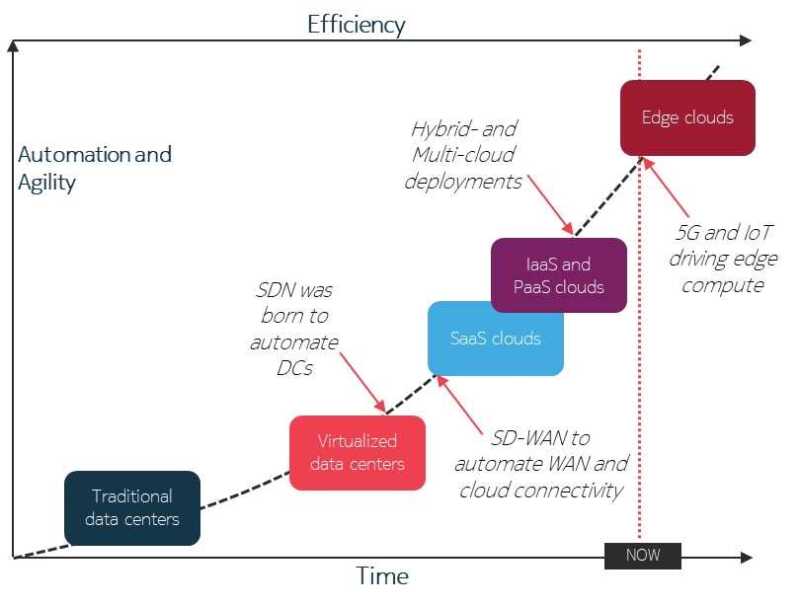As enterprises have adopted cloud-based architectures to drive the efficiency and scale of business applications, network automation through SDN and SD-WAN has been an essential ingredient to this proliferation every step of the way.

Figure 1. The evolution of cloud services
The cloud revolution started with the advent of virtualised private data centres. Prior to this trend, enterprise applications were delivered from dedicated servers & appliances with rigid network segregation via VLANs and DMZs. There was no network automation or agility to speak of. SDN emerged in the data centre (DC) – private cloud that is, with the task of delivering automated connectivity (virtual networks) and security across diverse virtual workloads.
While SDN emerged in the DC, SD-WAN was the use case that generated most hype. SD-WAN intended to securely connect enterprise branch sites to each other over any transport (Internet, MPLS or LTE), with a cloud-based management/control plane enabling agile network programming and providing application level insight.
As SD-WAN gained traction, public cloud services like Infrastructure as-a-Service (IaaS) and Platform as-a-Service (PaaS) started to gain mass market adoption as enterprises wanted to trade CAPEX for OPEX and start to host their business applications ‘in the cloud.’ These services offered flexibility and scalability, and many enterprises deployed hybrid clouds where both private and public cloud hosting options were used. The emergence of multi-cloud deployments followed where multiple public cloud services from different vendors were used to host the same application to enhance resiliency while avoiding vendor lock-in.
Several SD-WAN solutions catered to the needs of the adoption of public cloud services by deploying their SD-WAN management/control stacks through virtual gateways in the cloud, allowing these public services to be modeled as another branch office. This approach not only created further synergy between SD-WAN and public clouds, but it also allowed for public cloud connectivity to be automated with full fidelity of network policy and insight into public cloud applications. Furthermore, SD-WAN could now optimise the network based on public cloud application performance.
Software as a Service (SaaS) applications (Office 365, Salesforce or GitHub, etc.) was another form of cloud consumption prevalent across enterprises, irrespective of size or geography. SD-WAN ensured a seamless application performance for this type of cloud access by optimising network resources.
As enterprise network boundaries were being expanded and traffic was no longer delivered through a centralised hub, security concerns started to emerge. The attack surface increased dramatically, with “east-west” traffic being the source of most attack vectors. In order to deal with this scenario, SD-WAN needed to reinvent itself beyond the first generation of “connectivity-centric” solutions. Today, a next generation platform is needed that provides deep insight into east west traffic, with micro-segmentation all the way from users in branch offices to applications in the cloud, with automated responses to security events. It is also essential for the next generation SD-WAN to extend its policy to application end points in the cloud and not be restricted to the cloud periphery.
The other challenge for next generation SD-WAN solutions is to embrace and facilitate edge clouds which are emerging with the rise of 5G and IoT. These edge clouds move the cloud boundary closer to the enterprise to serve high bandwidth, latency sensitive applications.
Specifically, one type of edge cloud is formed by extending cloud infrastructures to the edge of the network, in a service provider’s facility, close to a 5G radio tower. This service is geared toward very low latency and high bandwidth applications. An example here is AWS Wavelength.
The other implementation we are seeing is public cloud infrastructures being deployed ‘on-premise’ for ultra low latency applications where often actionable analytics are also performed locally. These services are geared toward manufacturing and robotics where immediate feedback is needed.
With the distributed nature of edge clouds and corresponding services, the role of SD-WAN’s end-to-end visibility and control is now more important than ever to program the network to ensure that each application receives the service and performance it needs. The edge cloud services require secure, seamless connectivity to cloud components, as well as providing network SLAs that SD-WAN should measure and assure.
We have witnessed an incredible journey of digital transformation as enterprises have embraced virtualisation and the cloud. During this journey, SD-WAN capabilities have evolved to enable this transformation. Today, technology may be evolving even more quickly to accommodate the next generation of IT services unlocked by communication technologies like 5G. SDN and SD-WAN technologies will be essential to ensure that these services can be consumed with agility while eliminating any network restrictions.





